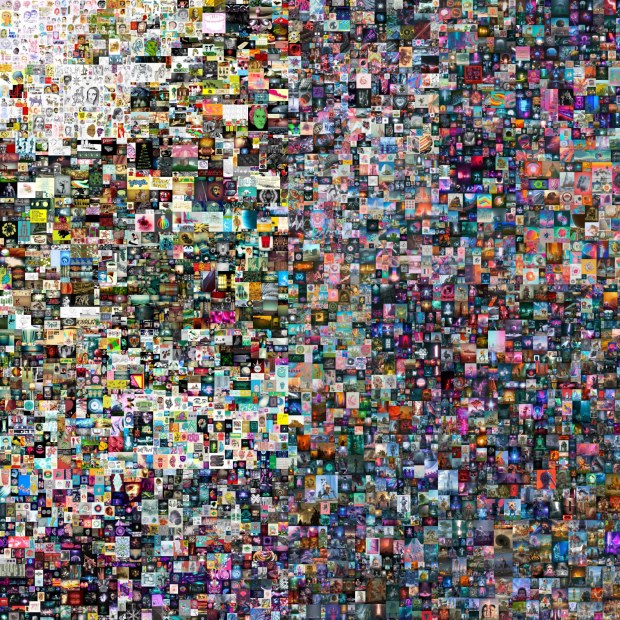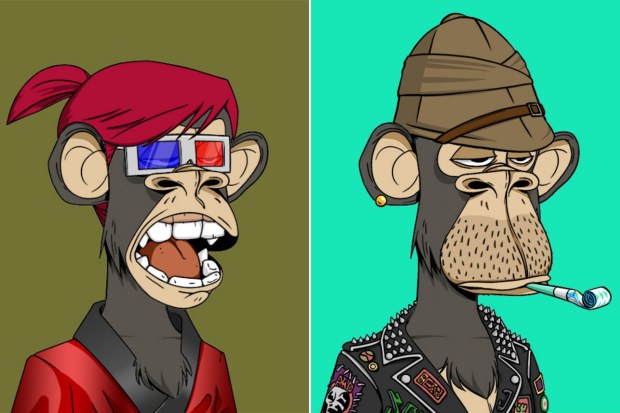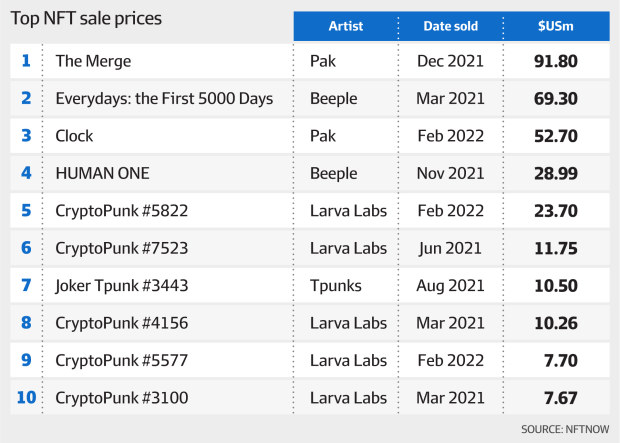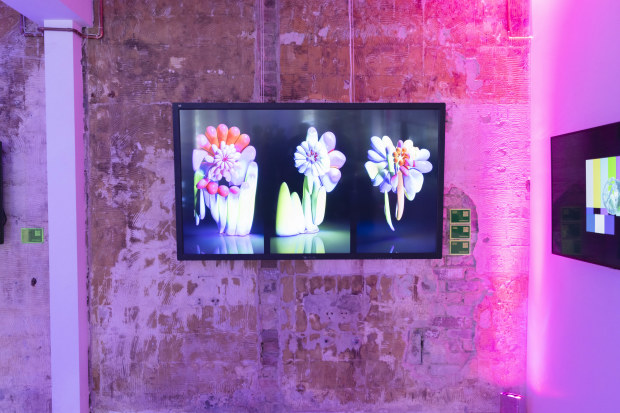From chequebooks to crypto wallets, how non-fungible tokens are changing fine art

All works are available through an online marketplace called Foundation, and the bidding starts around 1 ETH, or $3700 at the time.
Under the digital hammer
Over the past 18 months, the fine art world has undergone a radical digital makeover.
The champagne-sipping classes have downed their chequebooks and are instead entering galleries with their crypto wallets, hoping to buy the works of a new, desperately cool crop of digital artists.
Digital art has long been at the mercy of easy duplication online, making it difficult for artists, galleries and auction houses to assign provenance and value to items.

Everydays: The First 5000 Days, a digital collage by Beeple, which sold for $US69.3 million. Christies
But the recent introduction of NFTs, or non-fungible tokens, has given the art world a new tool for both provenance and cool, hip marketing in a world desperate to appeal to young, rich kids at home in the metaverse.
At its heart, an NFT is a piece of tradeable code attached to a digital item, such as an image or a video. A secure network of computers records the asset on a digital ledger, giving the buyer proof of authenticity and ownership. As the asset changes hands, the ledger records each owner.
These digital ledgers are public, and because an NFT is a programmable piece of code, artists and galleries can pre-arrange a commission back to the artist whenever that work is on-sold.
This, say auction houses such as Christies, is a great replacement for the paper-based certificate of authenticity that accompanies the sale of original artworks.
Last year, the 256-year-old auction house facilitated the sale of one of the most expensive NFT-related digital artworks so far. Beeple, an American digital artist otherwise known as Mike Winkelmann, minted his Everydays: The First 5000 Days to the blockchain, which then sold for $US69 million at auction.
The work itself was the collation of Winkelmanns 13-year effort to create and post a digital picture every day.
The sale blew peoples minds, and brought NFT technology to the mainstream consciousness, marking the start of an insane run in NFT-related digital artwork production.

Popular Bored Ape Yacht Club NFTs now sell for millions of dollars each.
Since Beeples Everydays sold in July last year, more than $US10 billion of NFTs have traded hands and more than 300 million NFTs have been minted across various blockchains, according to data by DappRadar, an analysis platform.
Bored Apes, a set of stoned-looking monkey pictures, now sell for millions of dollars each and act as exclusive tickets to high-end parties thrown by the Bored Ape Yacht Club, the group that minted the NFTs.
Sporting codes are minting NFTs to function as exclusive tickets for fans to meet players or to commemorate famous triumphs. Fashion brands are releasing waves of elite digital clothing items minted to NFTs.
But the advent of technology that proves who owns and who created digital assets has also exposed the darker underbelly of cryptocurrencies: the rampant, unregulated speculation and fraud.
Recently, a YouTube video called Line Goes Up: The Problem With NFTs went viral.
Created by Canadian documentary maker Dan Olson, it was a critical look at the underlying NFT technology and the salivating, hyperactive culture of cryptobros and their money-making agendas.
NFTs [are] the thing that is currently dominating the collective brain space of digital artists and sucking up all the oxygen in the room, Olson tells his viewers.
He tears apart the mechanics of bitcoin and ethereum, saying their volatility, laboured transaction times and fluctuating gas fees render them useless as a method for widespread payment.
But NFTs, he says, are a shiny front for the unsustainable bubble that is cryptocurrency speculation.
Because NFT-related artworks can be bought and traded using only cryptocurrencies, he points out they serve only as a means of boosting the value of the tokens used for purchase.
NFTs exist to get you to buy crypto, he says.
As part of his critique, he takes aim at the art work itself. The Bored Apes are not technically complex digital works, nor are CryptoPunks, another popular set of pixelated digital characters.
Often credited as the first NFT-minted digital art, 10,000 CryptoPunks were released for free midway through 2017 from Lava Labs, a Canadian design studio.
They were snapped up by internet-savvy people. Their expedition, many say, cements their importance in internet culture and therefore their value.
But Olsen points out that works such as CryptoPunks, which were free initially but now sell for millions, illustrate how broken and immature the NFT art market is.
None of this is about the art at all, but about the speculative value not what its worth to you, but what it will potentially be worth in the future to someone else, he says.
Groups of NFT traders gather in chat rooms and forums, plotting which newly released asset they will pile into next before cashing out and moving on.
Its not a market, its a casino, gambling on the receipt for an image or video thats otherwise infinitely digitally replicable, he says. The thing itself is immaterial as long as it can make a line go up.
And like anything to do with crypto, fraud lurks at every turn. In October last year, a female CryptoPunk (CryptoPunk #9998) sold for $US532 million.
But eyebrows were raised when it was discovered the owner of the work was actually trying to sell it to themselves, perhaps in a bid to pump up the price and create hype.

This tactic is known as wash trading, and widely recognised as a driver of volatile NFT prices.
But serious fine art buyers are developing ways to distinguish between a janky internet troll and the next Beeple, while keeping an eye on the NFT speculation that is rife within the frenzied world of online markets.
The Australian collector
Towards the back of the Satellite exhibition in south Bondi, there actually is a Beeple showing.
An electric purple animation called Into the Ether pulses gently on a high-definition screen.
It is not for sale, though a few quick conversations with other patrons reveal that this, and the neighbouring work by Trevor Jones, is a huge drawcard for people to attend.
Into the Ether shows two astronauts reaching towards a giant, glowing ethereum symbol. Ethereum is the blockchain that powers smart contracts, and the main technology that underpins NFTs.

Beside each screen is a QR code that prospective buyers can scan to see information about the artist, the starting price tag, and the underlying cryptographic signature that confirms it has been fixed to a blockchain.
Much of the highly sought-after digital art that is minted to NFT technology features crypto motifs in one way or another.
Although Into the Ether is a spacey image, people are gathering around Bitcoin Angel, part of a wider release by Trevor Jones, a Scottish artist.
Jones has animated Gian Lorenzo Berninis 17th-century Baroque sculpture The Ecstasy of Saint Teresa into a moving digital file. In the animation, Saint Teresa is in the arms of an angel who then stabs her with an arrow, watching on as golden bitcoins spill out of her chest.
I am trying to understand what is going on here when Marc Woodward, an investment manager at Melbourne-based Apollo Capital and owner of the Beeple and Trevor Jones artworks appears at my side.
Woodward, who made a venture capital career out of spotting and backing emerging technologies in Silicon Valley before moving to Australia, is an avid NFT collector.
These are great, he says, looking up at the Beeple and Jones works that he has lent to David Porte Beckefeld, the curator of the Satellite show.
Like a proud father, Woodward whips out his phone and shows me his collection of other digital artworks he has amassed, handily, alongside the boom in digital assets.
He says provenance for digital assets is a game changer. Liberal Senator Andrew Bragg, who is also at the exhibition opening, agrees.
Bragg has long been the face of the governments interaction with cryptocurrencies. He released a suite of recommendations regarding crypto regulation last year that Treasury is now considering.
But aside from his interest in the fledgling technology, noted for its potential disruption of banks and its volatile price movements, Bragg has long been an advocate of Aboriginal rights.
Speaking to the crowd at Satellites opening, Bragg outlines how NFT technology can be used to establish fair payment for the artist.
Weve all seen Indigenous artworks hanging in galleries with a price tag of thousands of dollars, he tells the gathered buyers.
And many of us know, in the back of our minds, that almost none of that money will go back to the artist living on Country, especially as the piece is sold again and again and the price gets higher and higher.
Collecting art is one of Woodwards passions, one mirrored across society in many ways.
Among his collection, Woodward has identified early movers trying out new techniques. He takes part in mass user-generated artworks.
I can view my collection wherever I go, I can display it anywhere, send them to friends and family as gifts, and if I choose to sell, I know a percentage will go back to the artist, he says.
As a collector in the digital domain, its powerful stuff.


